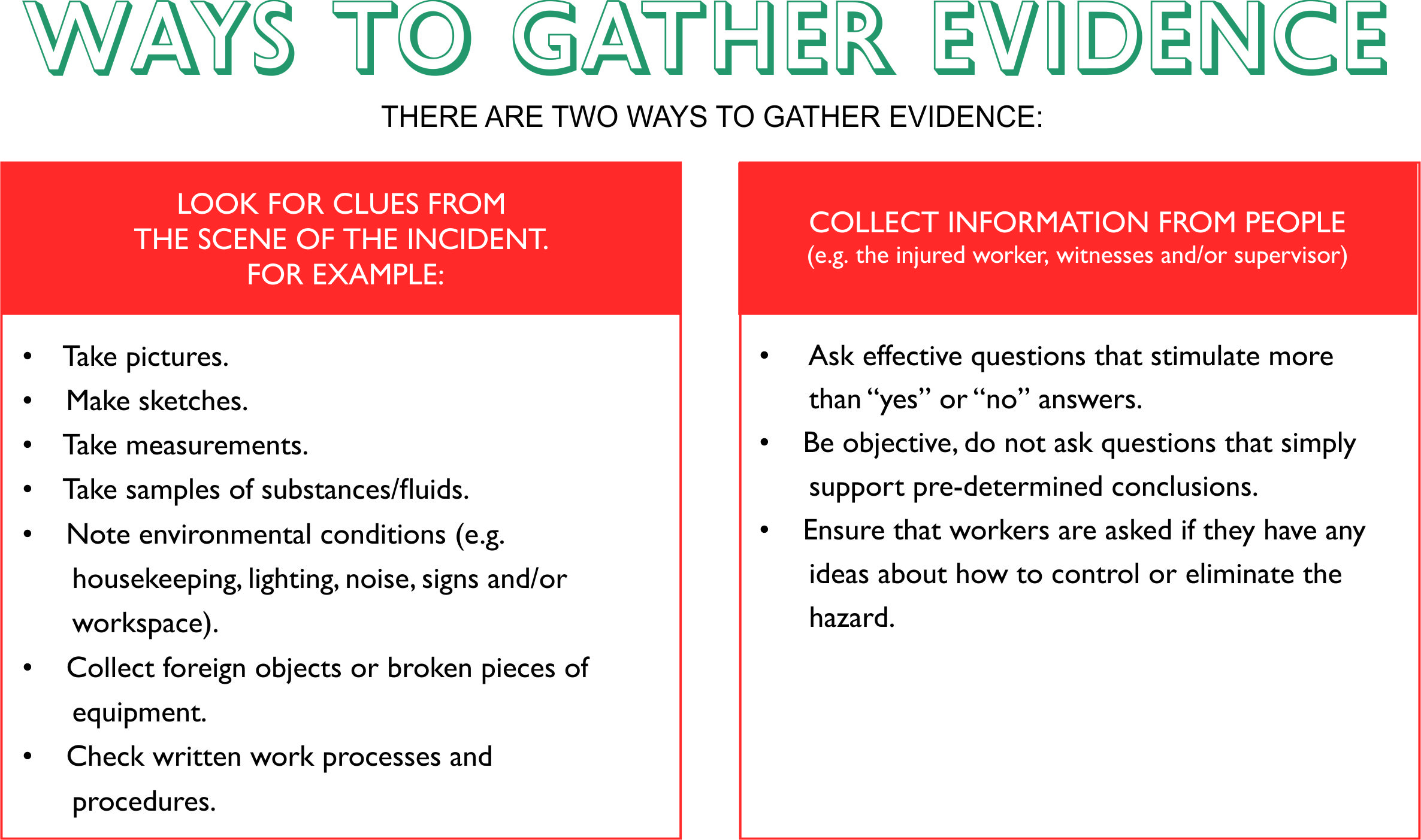There are several methods used to gather data about an incident:
- Inspection of the accident scene.
- Interviews of witnesses.
- Gathering of documents, procedures, practices, and processes evidence.
- Drawing of plans, taking photographs.
- Collecting physical evidence for forensic analysis.

Inspection of the accident scene - The first thing to do is to survey the scene to identify hazards. Then, identify the pieces of information you need to gather.
Interviews of witnesses - Every effort should be made to interview witnesses. In some situations, witnesses may be your primary source of information because you may be called upon to investigate an incident without being able to examine the scene immediately after the event. Witnesses may be under severe emotional stress or afraid to be completely open for fear of blame, Witnesses should be kept apart and interviewed as soon as possible after the incident.
If witnesses have an opportunity to discuss the event among them, perceptions may be lost in the normal process of accepting a consensus view where doubt exists about the facts.
Witnesses should be interviewed alone. You may decide to interview a witness at the scene where it is easier to establish the positions of each person involved and to obtain a description of the events. On the other hand, it may be preferable to carry out interviews in a quiet office where there will be fewer distractions. The decision may depend in part on the nature of the incident.
Gathering information on procedures, practices and processes evidence:
Physical factors – Did mechanical, environmental (e.g. weather) material (defective equipment) or other factors contribute to the incident?
Human factors – Did a person (e.g. worker, supervisor) fail to do something that contributed to the incident?
Organisational factors – Do you see or hear things that caused you to wonder if policies and/or procedures were in place, or that insufficient training, inadequate supervision or improper motivations are factors.
Drawing of plans, taking photographs - Take photographs - Photographs are the best way to document information. Make sketches - Sketches of the scene are valuable tools because they convey information that photos usually can't. Start with not-to-scale sketches drawn at the site. Use the measuring tape in your kit to measure distances, or estimate using your paces. Later, use your measurements to build a scale diagram.
Collecting physical evidence for forensic analysis - Most items of evidence will be collected in paper containers such as packets, envelopes, and bags. Liquid items can be transported in non-breakable, leak-proof containers. Arson (the burning of a building or other property for a criminal or malicious reason) evidence is usually collected in air-tight, clean metal cans. Moist or wet evidence (blood, etc.) can be collected in plastic containers at the accident scene and transported back to evidence receiving area.
After the initial investigation is complete the team should:
- Identify, label and keep all evidence. For example, tools, defective equipment, fragments, chemical samples, etc.
- Check to see if there have been any 'near misses' in similar circumstances.
- Note down all sources of information.
- Keep records to show that the investigation was conducted in a fair and impartial manner.
- Review all potentially useful information, including design specifications, operating logs, purchasing records, previous reports, procedures, equipment manuals, job safety analysis reports, records of training and instruction of the people involved and experiences of people in similar workplaces/industries.
- Reconstruct the incident (while ensuring that another incident does not occur) to assist in verifying facts, identifying what went wrong and what can be done to prevent it from happening again.